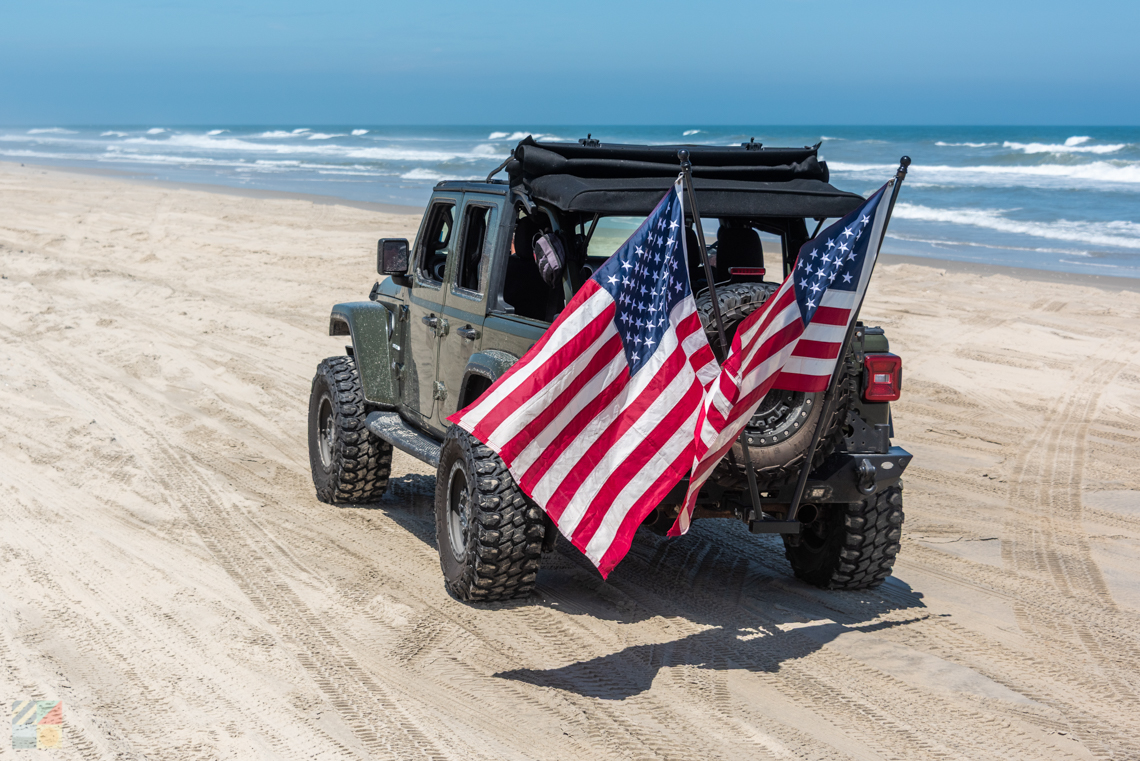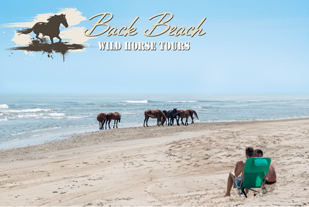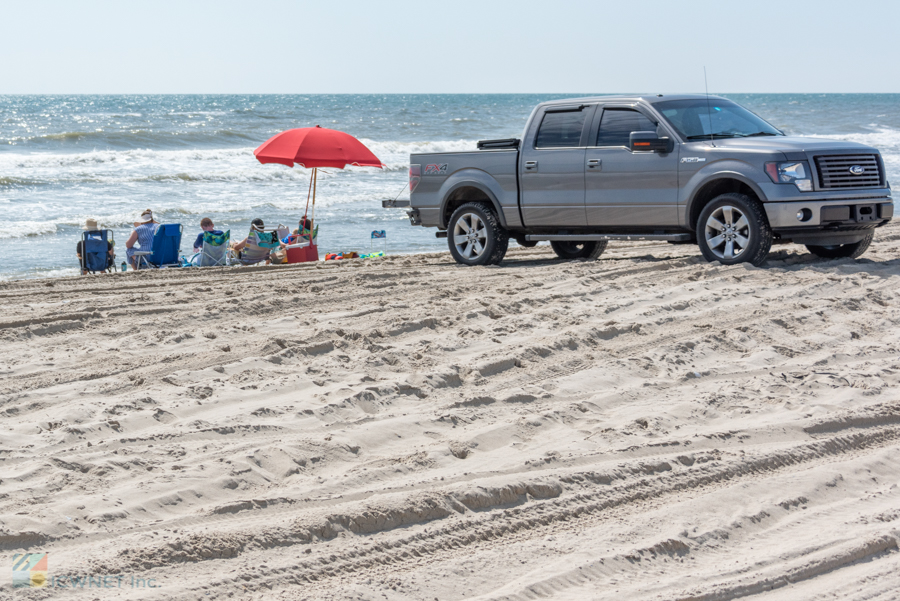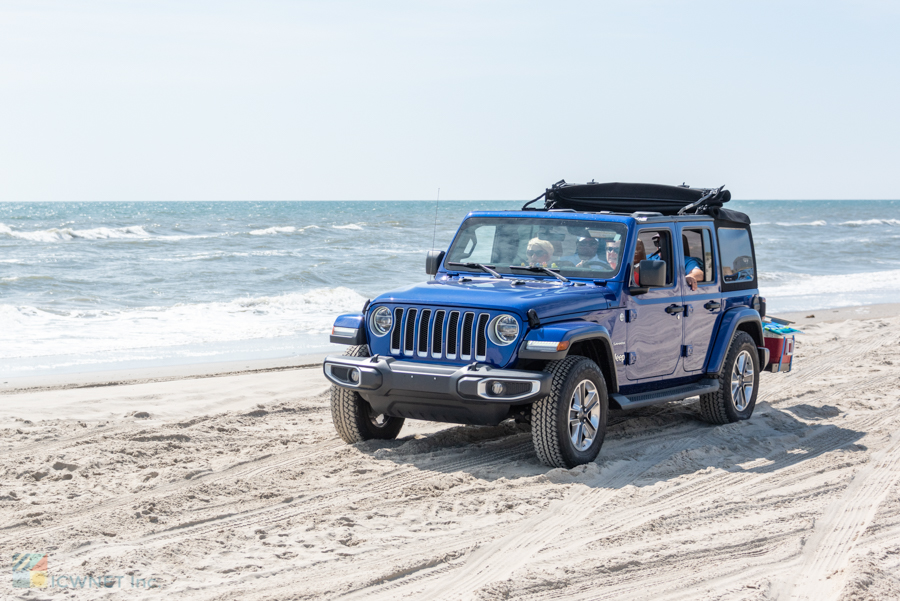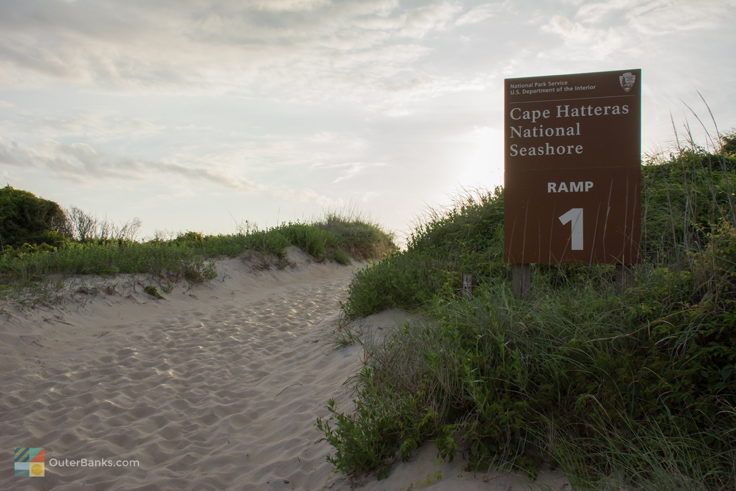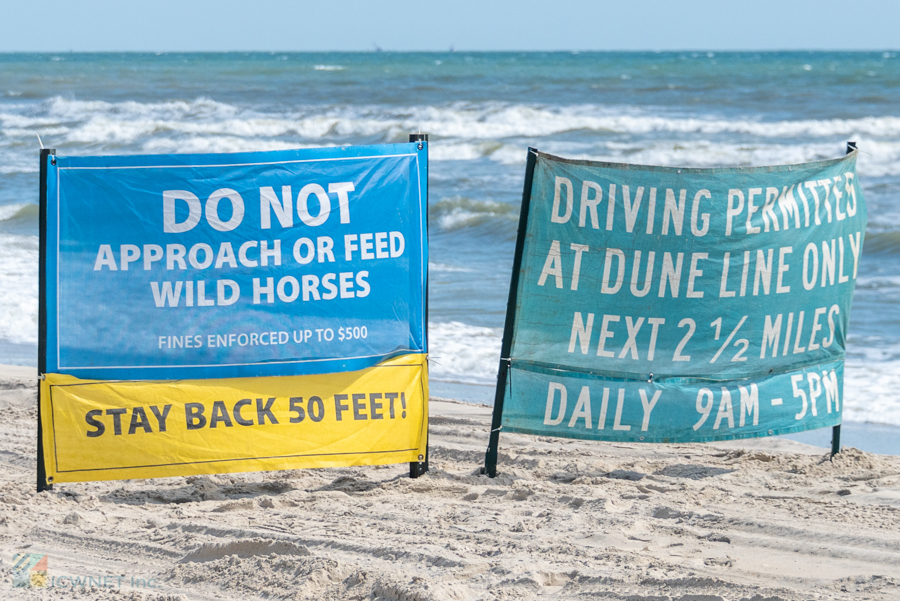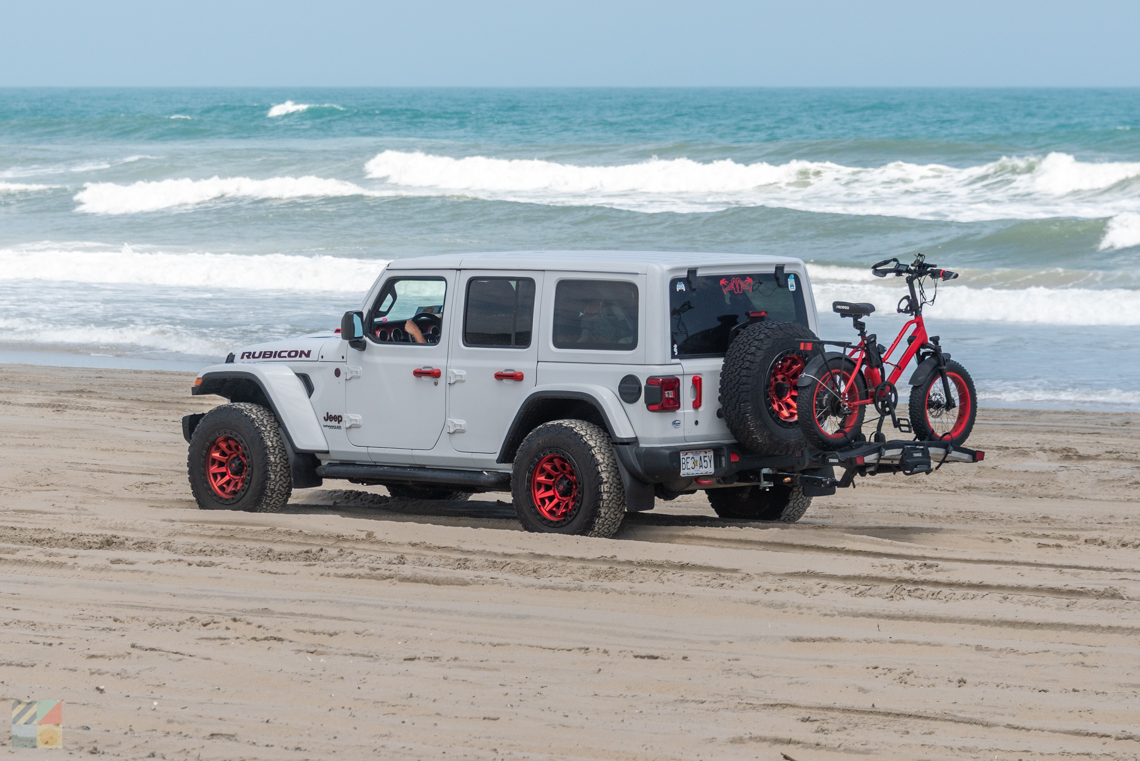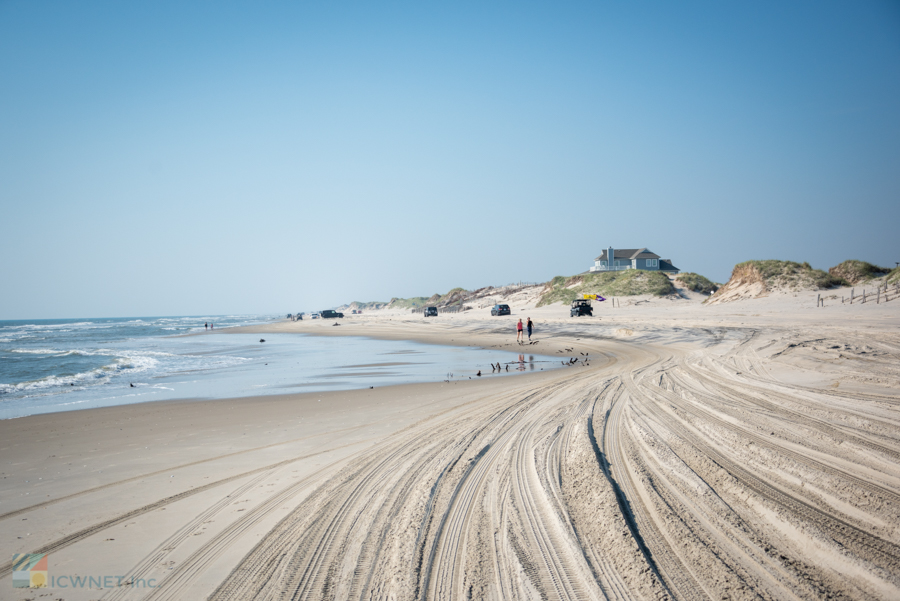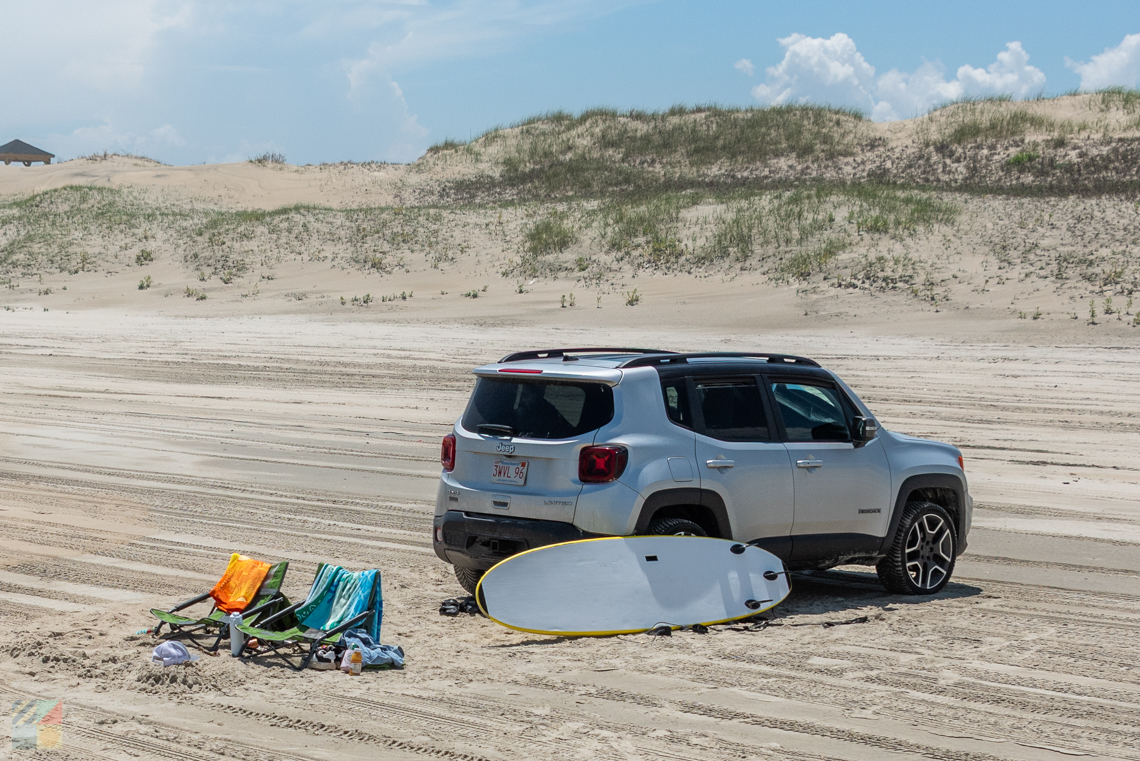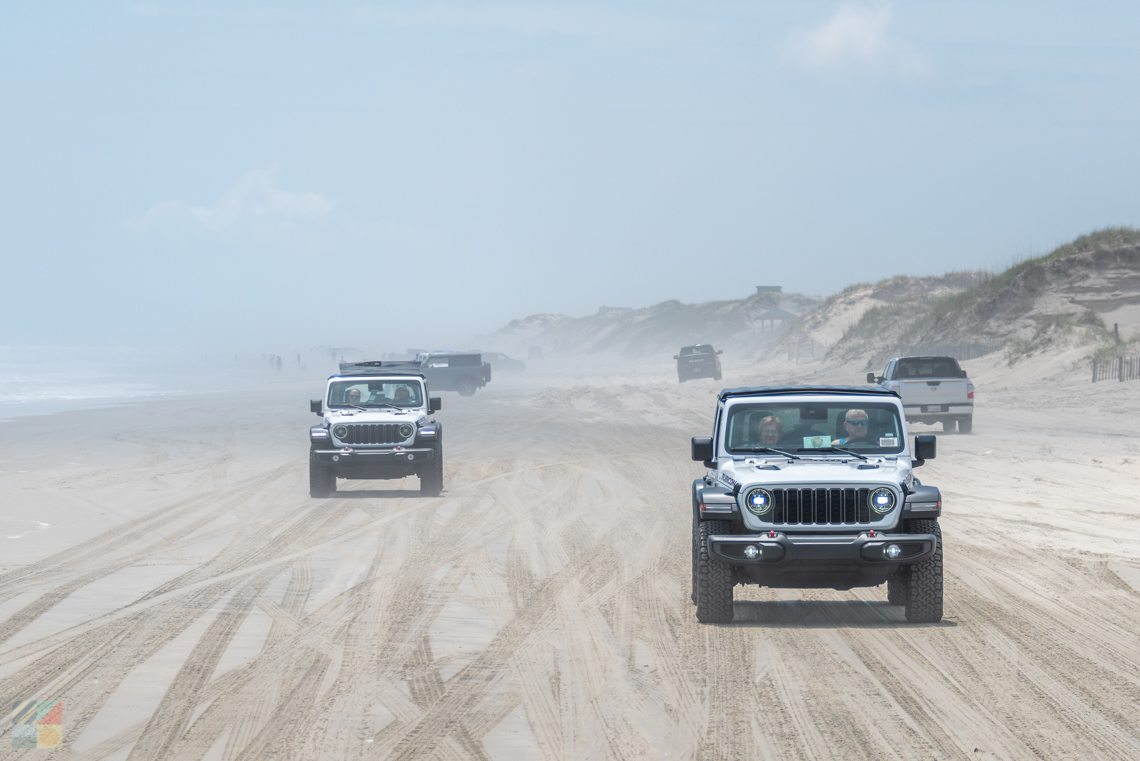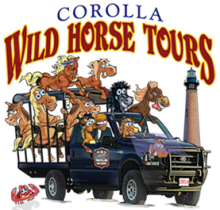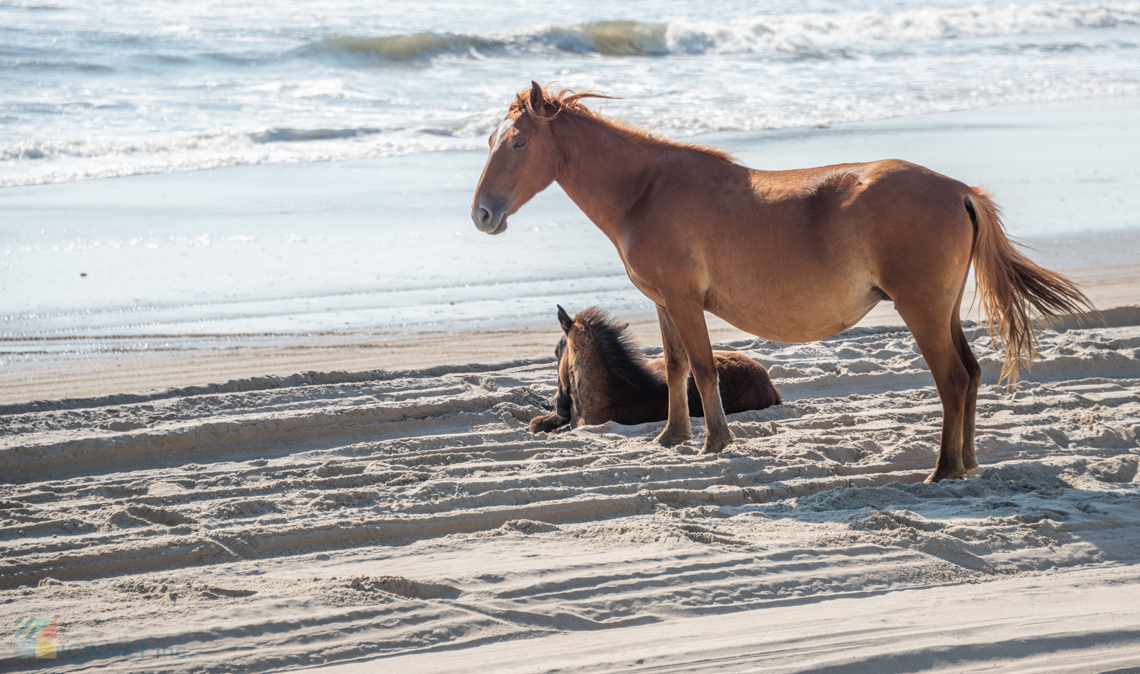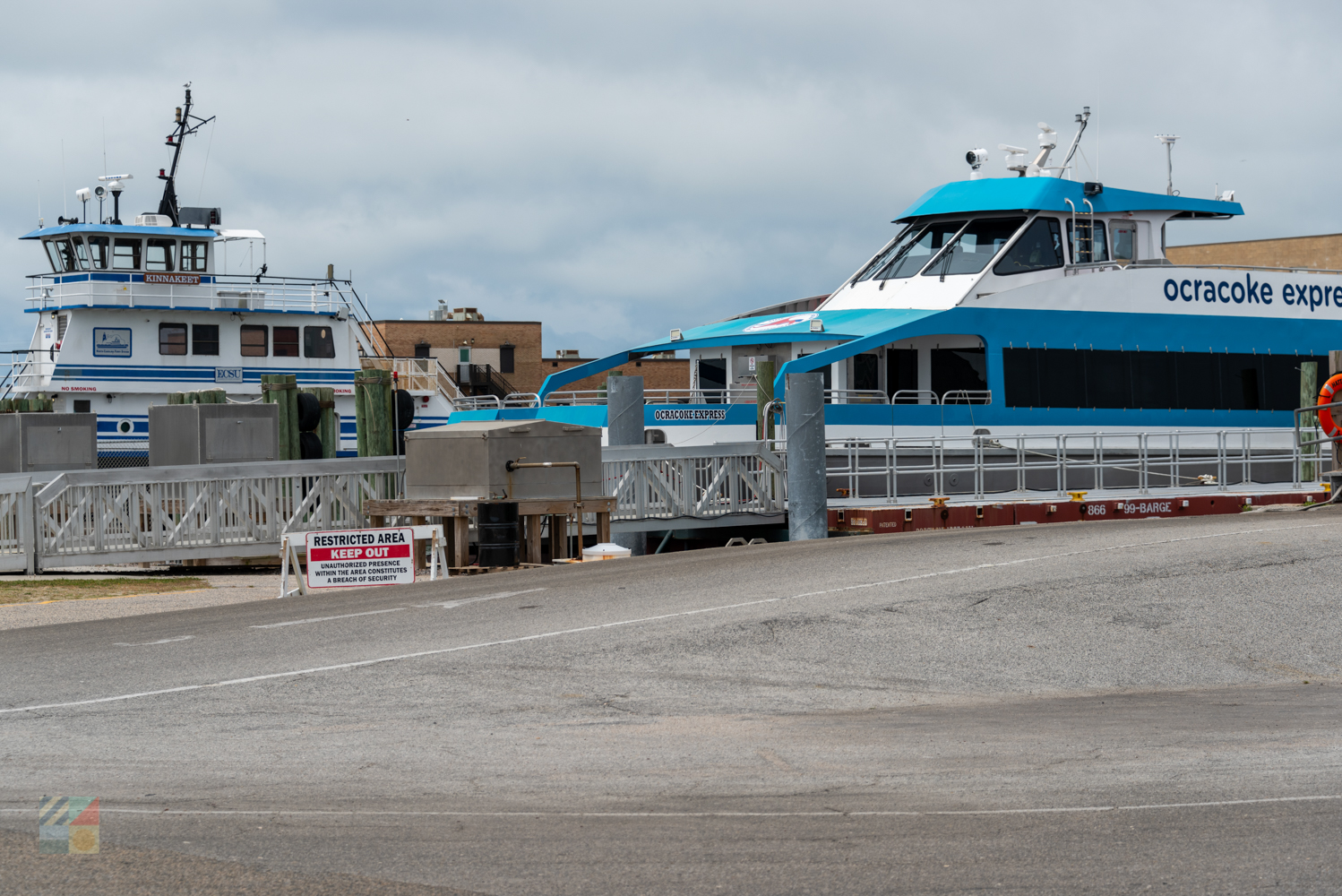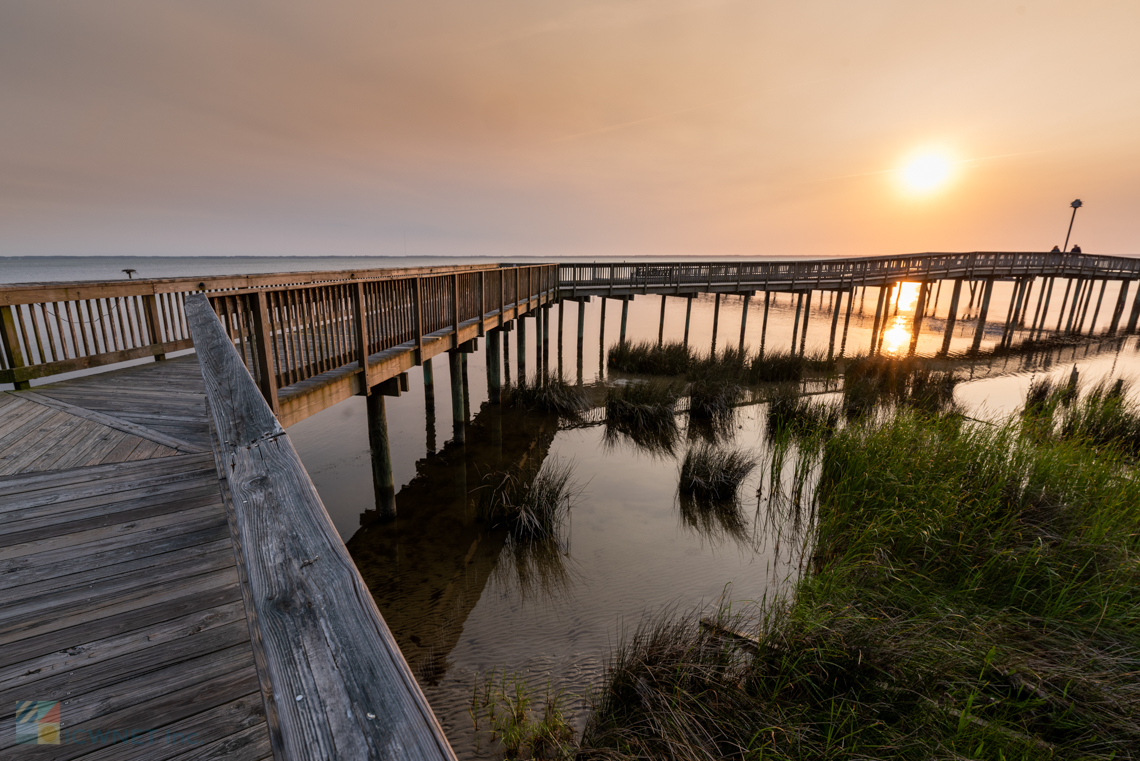4x4 Driving Guide:
- Rules
- Recommended Equipment
- Where and When
- 4x4 Cape Hatteras National Seashore Access Permits
- Corolla 4x4 Summer Parking Passes
- Tips and Tricks
- Getting Stuck
- Frequently Asked Questions
- 4x4 Access History
OuterBanks.com would like to thank Back Beach Wild Horse Tours for supporting this content. Back Beach offers professionally-guided 4x4 open-air tours across the remote beaches of Carova. Learn about local wildlife and history on your way to find the Wild Spanish Mustangs that inhabit our beaches and maritime forests. Tours are available March through Thanksgiving weekend, 7 days a week. Call 252-453-8602 for more information.
At its simplest, the two main 4x4 beach access areas are:
- Corolla/Carova - North end of the Outer Banks. No permit required to drive, but parking permits are required. Parking permit information can be found here. Vehicles MUST have a county-issued Beach Parking Permit properly displayed to park on the beach from the last Saturday of April through the first Saturday in October. Visitors renting in the 4-wheel drive area north of where the paved road ends should contact their rental company or property owner with any questions. Two parking permits should be provided to you. Visitors NOT renting in the 4-wheel drive area may purchase a weekly Beach Parking Permit online through the Currituck County website. Parking permits are limited to 300 per week and cost $50 each. Once purchased, the permits can then be picked up at the Currituck Outer Banks Visitor Center in Corolla (500 Hunt Club Drive, Corolla). Permits are limited, so we recommend purchasing yours early. This is the 4x4 beach to see the famous wild horses.
- South Nags HeadHatteras/Ocracoke Islands. Permit required. These beaches are maintained by the Cape Hatteras National Seashore (National Park Service). Great fishing areas!
One of the reasons so many vacationers flock to the Outer Banks is the thrill of driving on the beach, a rare privilege that few East Coast beach vacation destinations offer. On the Outer Banks, beach driving enthusiasts will find miles of shoreline to explore, from the uninhabited shoreline along Ocracoke Island to the solely 4WD accessible neighborhood of Carova, north of Corolla.
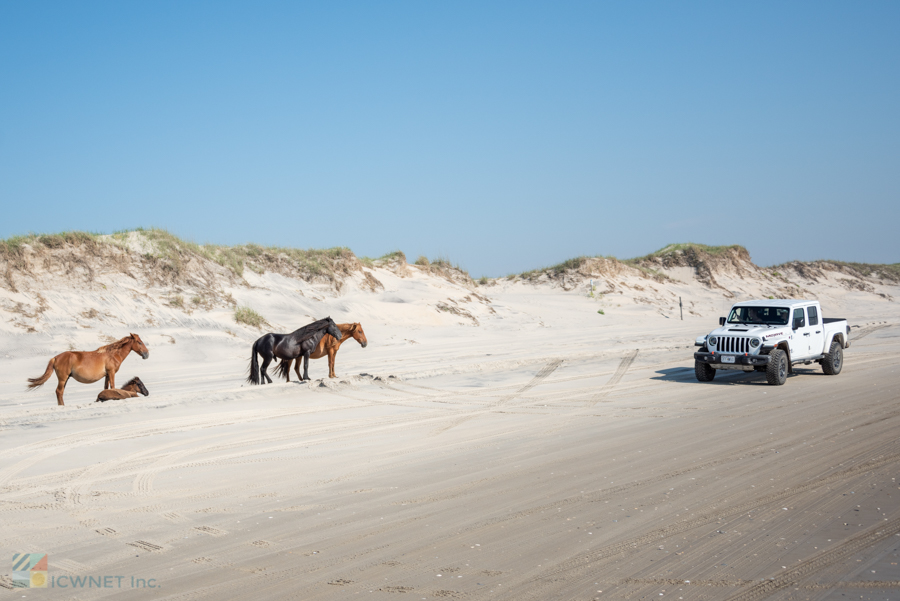
In fact, driving on the beach isn't just a favorite local pastime and a draw to adventurous vacationers and fishermen. On the Outer Banks, it's practically an institution.
General Beach Driving Rules
- 4x4 access and beaches often refer to the acronym "ORV", which stands for "Off Road Vehicle".
- Unless otherwise marked, speed limits are 25mph and 15mph or slower near others/pets/wild animals. Speed limit on Hatteras & Ocracoke Islands (Cape Hatteras National Seashore) is 15mph.
- Watch for fishing lines and children playing.
- Stay at least 50 feet away from wild horses.
- Never drive on dunes or vegetation.
- Obey all posted signs.
- Park perpendicular to the water in the middle of the beach.
- Traffic flows near the shoreline and dunes, with parked cars sitting between.
- Tow straps, shovel, spare tire, jack and jack board are recommended, and sometimes required to be in the vehicle.
- Open containers of alcohol are prohibited in vehicles
- Drivers need to have a current, valid driver's license
- Avoid driving or parking on the wrack line. The wrack line is a line of accumulated natural debris left by a previous high tide. Wrack lines are an important food source for birds.
- Pedestrians always have right-of-way on the beach
- UTVs and ATVs are generally prohibited, with some exceptions for local residents.
Currituck County (Corolla) Specific Rules
- Air Down Ordinance – No person shall drive or operate a motor vehicle on the beach strand or foreshore with tires containing air pressure exceeding the following pounds per square inch (p.s.i.): (1) Twenty p.s.i. for motor vehicles with curb weight of less than 5,000 pounds; (2) Tire p.s.i. not greater than that required for safe travel for motor vehicles with curb weight greater than 5,000 pounds.
- Air Down Location – Motorists should pull over to air down tires at the Corolla Village Road public access facility, which is located on the east side of N.C. 12.
- Air Up Location – After leaving the beach, motorists may air up tires at Historic Corolla Park, which is located on the west side of N.C. 12. Enter at main park entrance and turn right into parking lot. Air stations are located at the end of the lot near the picnic pavilion.
- Beach Driving Lane Shift to Dune Line – From the Friday before Memorial Day to Labor Day, between the hours of 9:00 a.m. and 5:00 p.m., the beach traffic lane will shift from the foreshore to a lane adjacent to the dune line only in the area 1.5 miles north of the beach access ramp to Mile Post 17.
- Do Not Block the Traffic Lane – All vehicles shall be parked in the middle of the beach strand and not obstruct the traffic lane. Likewise, no beach chairs, coolers, fishing lines, or other items should be placed in a location that blocks the traffic lanes.
- Remove Your Items When You Leave – Visitors should not leave any unattended property on the beach. Any property remaining on the beach between sunset and sunrise shall be considered litter and is subject to removal and disposal.
- Fill Your Holes – Excessive and unsafe digging or piling of sand on the beach is prohibited. Visitors must fill in any holes dug while playing on the beach to prevent safety hazards for those traveling on the beach.
- Help Preserve the Dunes – Remember that it is illegal to walk on or traverse the dunes outside of a defined dune walkover beach access point. Do not allow children or pets to play or dig on the dunes, and do not damage or remove any dune vegetation.
- Do Not Litter – Please remove all trash when you leave and help keep the Currituck Outer Banks beautiful for everyone.
Recommended Equipment
We've put together a short list of recommended items to get unstuck and stay safe. We like these linked products, but we took care to make sure they are highly-rated by many customers. Some of the product links include affiliate codes. *If a purchase is made, OuterBanks.com is paid a commission for the referral.
- Traction Mats - These make it easy to drive out of ruts when you've dug into the sand.
- High CFM Air Compressor - Save time and air up quickly.
- Tow Strap - Just in case. Allows anyone to tow you out of a tough spot. Or, help a 4x4 friend.
- Folding Shovel - Compact and capable of digging you out quickly.
- Tire Pressure Gauge - You'll need this in combination with your compressor.
- First Aid Kit - The further you are from roads, the more important this becomes.
- Fire Extinguisher - Another emergency essential in 4x4 terrain when emergency responders are miles away. Tip: Driving in the sand creates lots of heat. Keep an eye on coolant and transmission temps!
Where to drive on the Outer Banks beaches
Town Information (North to South)
- Corolla - 4x4 vehicles can access the beach at the Northern end of NC 12 where the paved road ends. 4x4 access North of this point is permitted year round. 4x4 access South of this point is permitted between October 1 and April 30. Driving at night is allowed. Overnight parking is allowed if the occupant is actively fishing. ATV's allowed for residents with permit. Starting 2018, parking permits are required on the Friday before Memorial Day until 11:59pm on Labor Day. Parking permit information can be found here. Permits are limited, so we recommend purchasing yours early.
- Duck - No public 4x4 access. Private access allows vehicles vehicles on the beach between October 1 - April 30.
- Southern Shores - Driving on the beach is prohibited.
- Kitty Hawk - Driving on the beach is prohibited.
- Kill Devil Hills - Driving on the beach is permitted with permit between October 1 - April 30 through designated access points. Vehicles must have current safety inspection, registration, insurance and license plate. Obtain a beach driving permit either from the Town of Kill Devil Hills or the Town of Nags Head. Through a reciprocal program, each town recognizes the beach driving permit issued by the other.
- Nags Head - Driving on the beach is permitted with permit between October 1 - April 30 through designated access points. Vehicles must have current safety inspection, registration, insurance and license plate. Obtain a beach driving permit either from the Town of Kill Devil Hills or the Town of Nags Head. Through a reciprocal program, each town recognizes the beach driving permit issued by the other.
- Rodanthe, Waves, Salvo, Avon, Buxton, Frisco, Hatteras, and Ocracoke - The beaches of Hatteras Island and Ocracoke Island are managed by the Cape Hatteras National Seashore. Permits are required, and can be purchased online and sent via mail, or in person at one of the following locations: Coquina Beach office, Cape Hatteras Light Station, and the Ocracoke Visitor Center. Each vehicle must have its own permit. Vehicles must be registered, licensed, insured, and have a current safety inspection if required in home state/country. Vehicles must have low-pressure tire gauge, shovel, jack and jack support board. A spare tire, first-aid kit, fire extinguisher, trash bags, flashlight and tow straps are recommended. ATV's are not permitted. Night driving is generally allowed from November 16 through April 30. See current access ramps and beach closings by visiting this page and clicking on the "daily beach access map". Obey all posted signs.
Carova - Note: Parking permits are required on the Friday before Memorial Day until 11:59pm on Labor Day. Parking permit information can be found here. Permits are limited, so we recommend purchasing yours early. One of the most notable locations to drive on the beach on the Outer Banks is the small village of Carova, and the neighboring beach communities of Seagull, Penny's Hill, Swan Beach, and North Swan Beach. (Although visitors will find that generally the majority of locals simply refer to the entire area as "Carova.")
To access the 4WD beaches of the Carova coastline, visitors simply take the sand ramp located at the very northern end of Corolla. From there, they can enjoy miles of beach driving, scenic ocean views, and if they're lucky, a glimpse of the wild horses, the area's first and most treasured local residents.
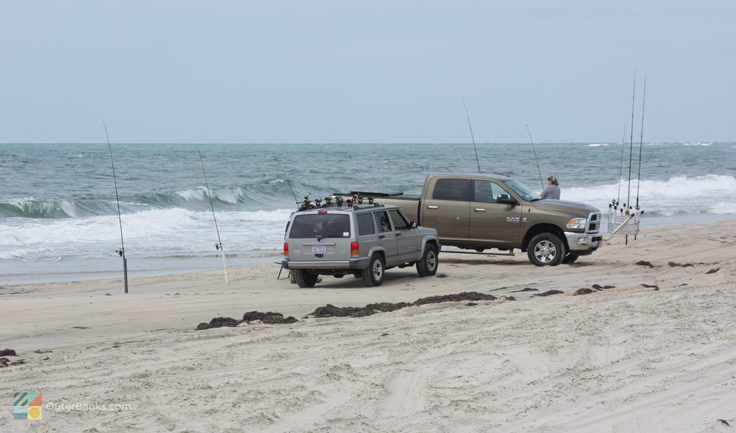
Nags Head, Kills Devil Hills and Kitty Hawk - The central Outer Banks beaches of Nags Head, Kills Devil Hills and Kitty Hawk generally also allow beach driving, during certain conditions. Beach driving in these popular areas is restricted to the off-season winter months, for the safety of beach-goers, and a town driving permit may be required depending on the location. Virtually hidden ramps are located along the beach road, next to public access, and winter vacationers will find they have miles of open shoreline to explore. Even if you're exploring the central Outer Banks beaches on foot, the wintertime is an exceptionally attractive time to go, as the area is not quite a ghost town, with plenty of restaurants and shops still open, but the beaches offer ample elbow room for fishing, shelling, or just enjoying a long secluded stroll.
Hatteras Island and Ocracoke - The Cape Hatteras National Seashore which comprises the beaches of Hatteras and Ocracoke Islands also offers miles of shoreline for beach drivers to explore, all marked by brown, National Park Service managed "ramp markers" that indicate the mile and entrance point of every beach ramp along these islands.
These beach access ramps begin with Coquina Beach, located just a few miles north of Nags Head, and extend all the way to the Ocracoke Inlet ramp, which literally borders the town of Ocracoke's city limits.
In between, vacationers will find a dozen seasonally open beach access ramps, including 4 in between the tri-villages of Rodanthe, Waves and Salvo and the town of Avon, one in between Avon and Buxton, one in the heart of Frisco, and one on the very southern edge of Hatteras Village that leads out to Hatteras Inlet.
On Ocracoke Island, visitors will find a handful of beach access ramps that begin just 100 yards or so from the ferry docks, and are located throughout the island all the way to the Ocracoke Inlet ramp. Because of Ocracoke's unique geographic location, the time it takes to get from the edge of the entrance of the beach access ramp to the oceanfront itself can vary greatly. For example, near the ferry docks, it's just a quick drive across the dunes to access the beach, but on the ramp closest to the village, drivers can expect to travel a long sandy road, (easily travelling a good mile), before arriving to the oceanfront.
All of the beach driving areas and ramps on Hatteras and Ocracoke Island are open seasonally, meaning that during certain times of year, (specifically in the summer months), some areas may be closed for threatened species that are breeding, or sea turtles that are nesting. The National Park Service has a weekly updated map on their website, which outlines the areas of the Cape Hatteras National Seashore that are open to pedestrians, vehicles, or both, and summer visitors are encouraged to check out their website to confirm which beach driving areas are open during their vacation.
4x4 Access Permits for Cape Hatteras National Seashore
Beach drivers on the Cape Hatteras National Seashore will need to obtain a Beach Driving Permit before hitting the shore, and can be purchased online and sent via mail, or in person at one of the following locations: Coquina Beach office, Cape Hatteras Light Station, and the Ocracoke Visitor Center. Each vehicle must have its own permit. Vehicles must be registered, licensed, insured, and have a current safety inspection if required in home state/country. Vehicles must have low-pressure tire gauge, shovel, jack and jack support board. A spare tire, first-aid kit, fire extinguisher, trash bags, flashlight and tow straps are recommended. ATV's are not permitted. Night driving is generally allowed from November 16 through April 30. See current access ramps and beach closings by visiting this page and clicking on the "daily beach access map". Obey all posted signs. To acquire a permit, a prospective beach driver must watch a 10 minute video regarding beach driving rules and regulations, and pay a weekly or annual fee, depending on the beach driver's preference.
Once a beach driving permit is secured, drivers are encouraged to pay close attention to the NPS rules and regulations which are posted at the entrance point of every beach ramp on the Cape Hatteras National Seashore. The rules are easy to follow, and include such guidelines such as maintaining (or not exceeding) a certain speed, keeping pets on a leash, tire pressure recommendations, or other general NPS rules.
The reward for jumping through the local hoops is access to some of the islands' best beaches, which are sparsely travelled and offer unparalleled shelling, fishing, and gorgeous oceanfront, sound, or inlet views.
Summer Parking Permits for Currituck County beaches (Corolla / Carova)
Starting in 2018, parking permits are required on the Friday before Memorial Day until 11:59pm on Labor Day. Parking permit information can be found here.
Tips for Driving on an Outer Banks Beach
- 4x4 is the Gold Standard - The first and foremost rule to beach driving is to use a 4WD vehicle. While some AWD or even front-wheel drive vehicles may be able to navigate through certain areas, specifically along the soundside or any beach that has hard, packed sand, the majority of the Outer Banks is comprised of deep and soft sand, which can only be navigated with a 4WD vehicle, particularly when it comes to making turns, or having to veer off the established tracks.
- Air down - Before hitting the shores, you'll also want to be sure and air down your tires. Slack tires are essential to navigating through the sand, and visitors are encouraged to decrease their tire air pressure to 15 - 22 PSI, depending on the beach conditions. (In other words, a lower PSI works much better in softer sand, while a higher PSI might be fine in harder, packed sand conditions.) In Corolla, please do NOT air down/up or leave your vehicle in the NC Coastal Estuarine Reserve parking lot (small parking lot just before the North end of NC-12). Instead, we recommend one of the Corolla beach access lots, or Historic Corolla Park lot.
- Air up upon returning to pavement - No need to worry about having slack tires for the rest of your vacation. The majority of local convenience stores and gas stations, particularly those closest to the beach access ramps, offer free air hoses so you can fill your tires back up before you travel too far along the pavement.
- Staying in tracks - Once on the beach, it is best, if possible, to stick to the established sand tracks that run along the high tide line. These tracks are formed by dozens of daily drivers that have consequently created a hard packed route, making driving along the beach an easier venture. Drivers will notice there are generally two sets of tracks, or "two lanes," along the shoreline, and are encouraged to follow the same rules as a regular road - stick to the farthest right tracks, don't pass unless necessary, and don't veer off the "beach" road.
- Wash down - Above all else, whenever possible, make sure you drive above the high tide line. Driving along the ocean wash will only splash saltwater into the undercarriage of your vehicle, (which can completely ruin a truck). We recommend spraying your undercarriage A.S.A.P. when your beach drive is over. Also, in the unfortunate case you get stuck, if you're located above the high tide line, you don't have to worry about the imminent threat of saltwater.
- Be Neighborly - The best rule of thumb for beach drivers is to be considerate. Don't air down your tires on the middle of a beach ramp, observe local speed limit regulations, and be mindful of the families and pets around you. The rules of the paved road also apply to the rules of the beach road, and beach drivers should follow this rule of thumb accordingly.
- Take some tools - We recommend carrying a small shovel, traction mats (floor mats work in a pinch), a jack (and jack board to put underneath), and tow rope. it just makes good sense to be prepared with basics.
If you get stuck
We've put together a short list of recommended items to get unstuck and stay safe
Even the most seasoned local beach driver can get stuck on the sand from time to time, and with a few extra precautions and measures ahead of time, getting stuck on the beach can easily turn into a funny vacation story, instead of a frustrating vacation headache.
Before you hit the sand, make sure you have a shovel, two 2' x 4's (about 4-6' ft. in length), and a tow rope, which can be purchased at virtually any hardware store.
While driving along the beach, if you feel yourself getting stuck in the sand, the most important thing is to not try to force your way out. Spinning your tires will only drag you deeper down into the soft sandy ruts.
Instead, hop out of the vehicle, and start digging behind or in front of your tires, depending on where your tires are lodged the deepest, and where the easiest route off the patch of sand is. Once an uphill path is created, you can try to move the vehicle again, or you can lay down the 2' x 4's, giving your vehicle some stable ground to drive on.
Still stuck? Many new beach drivers are surprised and delighted to find how many of their beach driving neighbors are willing to help. Chances are, if there is a vehicle passing by or parked up the beach, they will probably pause and assist you in getting out of the sand. This is where the town rope comes in handy. Just be sure that the vehicle that is pulling you out is an equal size and weight or more, or else you very well might both get stuck in the process.
As a last resort, the Outer Banks is also home to a number of towing companies that are stationed throughout the beaches, and are particularly concentrated around areas that are popular with beach driving, (specifically, Carova and Hatteras and Ocracoke Islands.) Always on call, a local towing company can assist you year-round, and can have your vehicle out of the sand in no time.
Yes, getting stuck is always a risk when it comes to beach driving, but sandy drivers on the Outer Banks find the risk is most certainly worth the reward. As one of the few coastal destinations where vacationers can jump in their truck and head to the ocean, beach driving is a decades-old way of life that has been maintained and celebrated on the Outer Banks, and is as old as tourism on the OBX itself.
By taking a drive along the beach, vacationers will find they can easily pack all the gear they desire, discover new and inviting locations, and basically tour huge parcels of the Outer Banks shoreline without even stepping out of their vehicle.
For a different perspective on the standard beach day, load up the truck, the family, and even the pets, and drive out onto the sand for a fantastic, uniquely Outer Banks adventure. Chances are that after a leisurely spin along the shoreline, like generations of vacationers, you'll be simply hooked.
Frequently Asked Questions
Where can you drive on the beach on the Outer Banks?
Beach driving is allowed on multiple shorelines from Carova to Ocracoke Island. The most popular destinations for year-round beach driving is the 4WD accessible beaches north of Corolla, Hatteras Island, and Ocracoke Island. Wintertime beach driving is also allowed in central Outer Banks communities including Nags Head and Kill Devil Hills.
Where is beach driving prohibited on the Outer Banks?
Beach driving is not allowed year-round in the towns of Southern Shores and Kitty Hawk.
Are ATVS allowed on the Outer Banks?
ATVS are not allowed on the Outer Banks from Corolla to Ocracoke Island. They are allowed in isolated Portsmouth Island, which is located just south of Ocracoke Inlet, and which is part of the Cape Lookout National Seashore.
When is beach driving allowed on the Outer Banks?
In remote areas like Hatteras and Ocracoke Islands, which is part of the Cape Hatteras National Seashore, beach driving is allowed year round. Beach driving is also allowed year-round on the isolated 4WD beaches north of Corolla. In central towns like Nags Head and Kill Devil Hills, beach driving is only allowed in the off season months, or roughly October until April.
Can you drive on the beach in Corolla?
Beach driving is allowed north of the paved NC Highway 12 in the Carova area year round. Beach driving may also be allowed south of the ramp in the northern Corolla beaches from October through April. Parking permits are required on the Friday before Memorial Day until 11:59pm on Labor Day. Parking permit information can be found here.
Can you drive on the beach in Duck?
Beach driving is allowed in Duck from October through April, however there are no public 4WD beach ramps within the town limits. Vehicles can utilize private 4WD access ramps only.
Can you drive on the beach in Nags Head?
Driving on the beach is allowed in Nags Head from October 1 until April 30. A beach driving permit is required, and can be picked up at the Town of Nags Head or Town of Kill Devil Hills town halls, or at area tackle shops.
Can you drive on the beach in Kill Devil Hills?
Beach driving is allowed in Kill Devil Hills in the off-season months of October through April. A permit is required, and can be obtained at the town halls of Kill Devil Hills or Nags Head.
Can you drive on the beach on Hatteras Island?
Driving on the beach is allowed year-round at designated ORV ramps throughout Hatteras Island, and the Cape Hatteras National Seashore. (Hatteras Island has a total of 11 ORV ramps.) A beach driving permit must be obtained first, and can be picked up at the local ranger stations by Oregon Inlet and in Buxton, or online at the National Park Service website.
Can you drive on the beach on Ocracoke Island?
Driving on the beach is permitted at a number of beaches on Ocracoke Island, year round. Beach drivers must obtain a beach driving permit first from the National Park Service website, or in person at the ranger station near the Ocracoke Campground.
Do you need a permit to drive on the beach on the Outer Banks?
A beach driving permit is required for driving on all Outer Banks beaches, except the northern 4WD beaches of Carova. Permits are available from the National Park Service for driving in the Cape Hatteras National Seashore, or from the respective towns, (like Nags Head or Kill Devil Hills), in the central Outer Banks. Parking permits are required on the Friday before Memorial Day until 11:59pm on Labor Day in Corolla/Carova. Parking permit information for Corolla beaches can be found here.
Where can you get a beach driving permit on the Outer Banks?
In Nags Head and Kill Devil Hills, off-season beach driving permits can be picked up at the local town halls and / or at area tackle shops. On Hatteras and Ocracoke Islands, beach driving permits can be obtained at the islands’ three National Park Service ranger stations, or via the Cape Hatteras National Seashore’s website.
Do you need a 4WD vehicle to drive on the Outer Banks beaches?
Visitors most definitely need a 4WD vehicle to drive on the Outer Banks beaches to avoid getting stuck in the soft sand.
Can you drive on the Outer Banks beaches with an all-wheel drive (AWD) vehicle?
Visitors are discouraged from driving on the Outer Banks beaches with an AWD vehicle. A 4WD vehicle is needed to navigate the soft sand.
Do you need to air down your tires to drive on the Outer Banks beaches?
Where can you get air for your tires on the Outer Banks?
The majority of gas stations and convenience stores close to ORV ramps on the Outer Banks have air available for vehicles to refill their tires. Air is often free for customers, particularly on Hatteras and Ocracoke Islands.
What should you do if you get stuck driving on the beach on the Outer Banks?
Make sure to have the recommended equipment before dricing on the beach. Visitors that get stuck on the beach can try removing excess sand from their tires and creating a clear path, (or track), to get out of the soft sand. Wooden boards or traction mats can also come in handy, as they can provide a solid surface to drive on when trying to get out of the sand. DO NOT attempt to continue going forward if you are stuck, as it will make the vehicle dig deeper into the sand. As a last resort, visitors can also ask other, larger 4WD vehicles for help, or call a local tow truck company.
Are there tow truck companies on the Outer Banks?
There are multiple towing companies on the Outer Banks from Corolla to Ocracoke Island, which can assist vehicles that have gotten stuck while driving on the beach.
Can you drive on the beach at night?
Driving on the beach at night is permitted in many areas of the Outer Banks, primarily in the off-season months of October through March or April.
Can you get a ticket for driving on the beach without a permit on the Outer Banks?
Visitors who drive on the beach without the appropriate beach driving permit may be subjected to a ticket and a hefty fine.
What are the rules for driving on the beach on the Outer Banks?
Though the rules vary from location to location on the Outer Banks, in general, the regulations and beach etiquette guidelines for beach driving are as follows:
- Follow established tracks in the sand.
- Observe all posted speed limits, which typically range from 15 to 35 mph, depending on the area.
- Do not drive in the dunes, or well above the high tide line.
- Do not drive in the ocean wash to ensure the safety of beachgoers, and to avoid saltwater damage to your vehicle.
- Air down your tires to 15-22 psi before driving on the beach.
- Only access the beach with a 4WD vehicle.
- Do not air down your tires or park directly on the ORV ramp or in established tracks.
- Do not drink and drive. Remember that the rules of the road also apply to the beach.
- Stay away from wild horses on the northern Corolla beaches, and other wildlife. Pay attention to seasonal nesting closures, and do not drive through these areas.
What tools or gear should you bring to drive on the Outer Banks beaches?
Click HERE for our recommended beach-driving equipment guide. Visitors should pack along a handful of items to allow them to drive safely on the beaches, and to assist if they get stuck in the sand. These items include:
- Tire gauge
- Wooden boards or traction mats
- Tow strap
- Shovel
- First aid kit for isolated areas
- Contact info for area towing companies, just in case
Why should you pack boards for driving on the beach on the Outer Banks?
Traction mats provide a solid surface in case you get stuck on the beach. Inexpensive and easy to pack along, the boards can be placed under the submerged-in-sand tires to drive out of a beach rut.
Should you tow another vehicle that is stuck on the beach?
It’s not uncommon for other 4WD vehicles to assist trucks that are stuck in the sand by towing them out. This should only be done if your vehicle is larger and/or more powerful than the stuck vehicle, (or is about the same), and the stuck vehicle isn’t too submerged in soft sand.
Will pulling out a vehicle that is stuck on the beach damage your truck?
It’s possible that trying to pull out a vehicle that is stuck may cause some damage you your own truck, or can lead to you getting stuck yourself. Proceed with caution, and do not attempt to tow vehicles that are much larger than yours, or that are stuck in very deep ruts.
Is saltwater bad for your vehicle?
Saltwater can cause long-term rusting and permanent damage to a vehicle. The risk for damage increases the deeper the saltwater is, and the longer that the saltwater remains on the undercarriage of the car or truck.
What should you do if you drive through saltwater on the Outer Banks?
Travelers that drive through saltwater should immediately hose off their vehicle, and especially the undercarriage of the car or truck. Head to a local car wash, (there are many throughout the Outer Banks), and focus on the underneath of the vehicle after driving through saltwater.
4x4 Beach Driving History
For decades, the only way for vacationers to even access the majority of the Outer Banks beaches was by hitting the sand, making a visit to the OBX a rustic and downright tricky adventure.
Before NC Highway 12 was built all the way to Corolla in the late 60s and early 70s, visitors had to follow sandy paths, from either the north along the Virginia state line, or from the south via the more developed beaches of Nags Head, Kill Devil Hills and Kitty Hawk. The 20 mile or so trip was a tricky one, with unpredictable high tides and mud flats that could easily slow a driver down.
After Corolla and Duck were developed, homes slowly started springing up along the Outer Banks northernmost beaches, under the assumption that NC Highway 12 would eventually follow its northern path all the way to the Virginia state border.
But due to a number of property ownership factors and environmental concerns, that never happened, and instead, a well-worn sand "road" was haphazardly created, allowing trucks of all sizes to access the small northern villages.
Today, this area is home to a varying collection of vacation rental homes, ranging from shaded 3 bedroom soundside cottages to behemoth oceanfront rental homes. Though the landscape and variety of accommodations may have changed, one factor remains the same - the only way to get to this area is via a 4WD vehicle and a ride along the Outer Banks shoreline.
Frequent Carova vacationers love this attribute, as it means that the area remains sparsely populated, with no commercial businesses or large complexes to intrude on the natural landscape. In fact, because of its limited population, the area is also the centuries-old home of the Carova Wild Horses, who roam the beaches freely without any worry of encountering highway traffic.
Conditions were similar on Hatteras Island, which until the construction of the Herbert C. Bonner Bridge in the early 1960s, was only accessible by a privately run ferry owned and operated by Captain Tillet.
Once successfully ferried across the Oregon Inlet to the island, drivers could either follow the oceanfront beaches to the main villages, (with sand that was as deep and soft as it is today), or attempt to follow a series of sporadically used small trails that veered from the ocean dunes to the soundside. Taking either path was a tricky endeavor, and adventurous vacationers could expect the trip from Nags Head to the main villages of Hatteras Island to take several hours in the very best of conditions.
Thankfully, after decades of development and subsequent paved roads and bridges, the hike to get to some of the Outer Banks' most treasured and quiet vacation destinations is by all means no longer an ordeal. But the love of driving on the beach has never quite disappeared from these beaches, both among locals who have been driving along the beaches their entire life, and newcomers who love the convenience of driving until they find that perfect, secluded beach spot.
Ready to take the 4WD vehicle out for a spin? Beach driving is a time-tested and fun activity on the Outer Banks that's open to everyone, locals and visitors alike, and many folks find after that first initial trip, they are officially dedicated to exploring beach spots well off the beaten path.
OuterBanks.com would like to thank Back Beach Wild Horse Tours for supporting this content. Back Beach offers professionally-guided 4x4 open-air tours across the remote beaches of Carova. Learn about local wildlife and history on your way to find the Wild Spanish Mustangs that inhabit our beaches and maritime forests. Tours are available March through Thanksgiving weekend, 7 days a week. Call 252-453-8602 for more information.
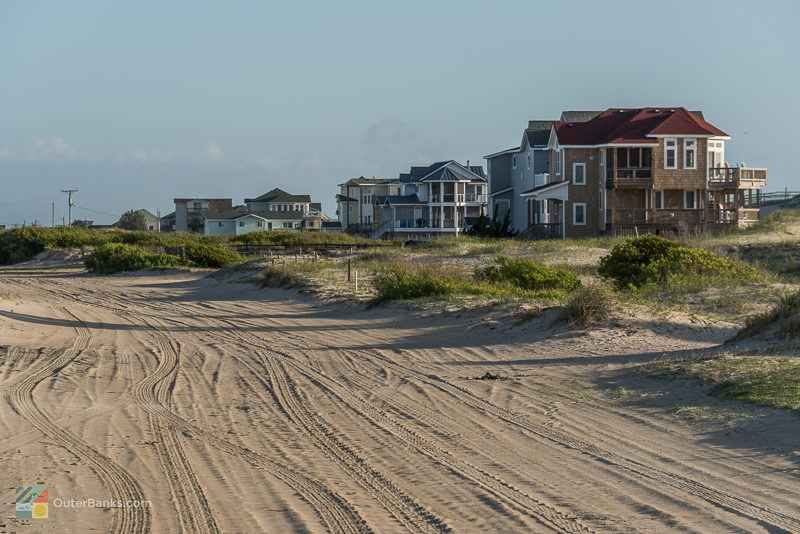
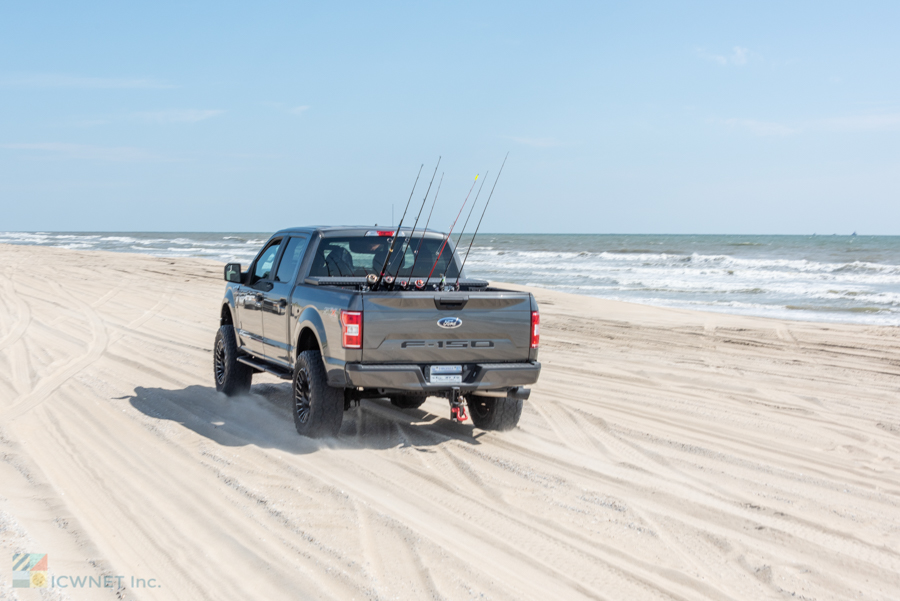
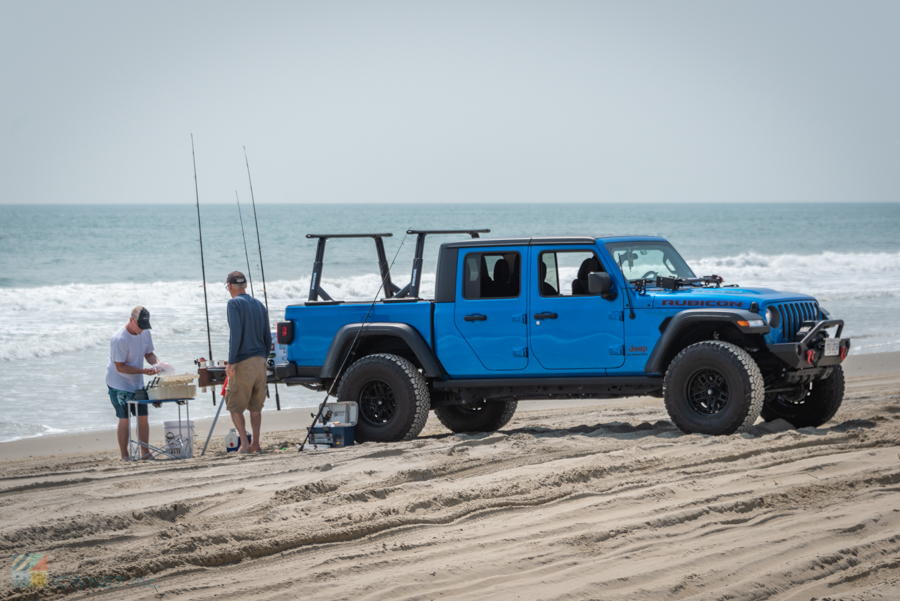
We are the only Authorized Shipping Center on the OBX for FedEx, UPS and DHL. Come to OBX Shipping Center for all your shipping and office needs. We offer Notary services, copies, faxing, laminating, among other office services. You do the shopping… and we'll do the shipping!
Flight takes many forms on the Outer Banks, from the thousands of migratory birds that travel along these barrier islands to and from their winter destinations, to aviation pioneers like the Wright Brothers who launched the world's first airplane off the sand dunes of Kill Devil Hills. Visitors can also experience the Outer Banks' inherent love of all things aerial by taking flight themselves with a day of Hang Gliding.
Home of the Crab Leg & Lobster Buffet for 26! years! Jimmy’s Seafood Buffet is a great stop for an all you can eat affordable dinner extravaganza. The buffet offers over 100 different items. It even serves Jumbo Alaskan crab legs and Jumbo steamed shrimp, something you will not find on any other buffet in the OBX. The buffet offers a variety of seafood and non seafood options. Try some of Jimmy’s seafood options and load your plate with blackened tuna, Louisiana crawfish, steamed scallops and mussels, fried oysters and deviled crabs. Not in the mood for seafood? Fill your plate with steak, pineapple glazed ham, fried chicken, BBQ ribs, and fettuccini Alfredo to name a few. The buffet also offers a kid section. Let your kids load their plates with chicken tenders, mac and cheese, and corn dog nuggets. Don’t forget dessert! The buffet also offers soft serve ice cream and a plethora of baked goods. It’s been 25 years since Jimmy’s Seafood Buffet opened its doors for the first time. Since that inaugural summer, the goal has remained the same: provide customers with a tasty, fresh array of seafood full of Caribbean flavor. Elizabeth Dowless and her husband Jerry had always worked in restaurants in the Outer Banks, so when the opportunity to open Jimmy’s Seafood Buffet with a couple of friends arose, it was an easy yes. The Dowlesses bought out the business in 2003, excited to turn Jimmy’s into an Outer Banks staple. When Jerry passed away later that year, Dowless knew she wanted to continue pursuing their dream on her own. Dowless went all in on the concept of a fresh, flavorful seafood buffet and her hard work paid off. Jimmy’s Seafood Buffet is a beloved fixture of Outer Banks dining, with customers returning year after year for the fresh fare. “Customers keep in contact with me throughout the winter. I get people every day asking me when we’re opening for the season, and customers book their vacations around our opening,” Dowless says. “I absolutely love getting to see familiar faces come back to see us each year. I love seeing them lose their minds over the buffet! Their excitement is what I love most about my job.”
The Outer Banks has its fair share of attractions for vacationers, including the Wright Brothers Memorial, 4 famous North Carolina lighthouses, the NC Aquarium, the Lost Colony, and enough shopping and dining to keep any family entertained for a week-long vacation. But the biggest attraction that draws seasoned Outer Banks vacationers back every year are the miles and miles of pristine beaches.
Kitty Hawk Kites has been Teaching the World to Fly since 1974 and is home to the world’s largest hang gliding school. As the Outer Banks leader in quality outdoor recreation and adventure, Kitty Hawk Kites offers more than 30 activities to choose from, so get out that pen and start crossing things off your OBX bucket list today! Visit KittyHawk.com or call 1.877.FLY.THIS to book your Kitty Hawk Kites adventure today.
It might seem tricky to fit in all the attractions, historical sites, and fun activities off the beach into an Outer Banks vacation, and still have plenty of time left over to just lounge on the sand. That said, there are a number of attractions up and down the North Carolina coastline that any new visitor would be remiss to miss.
Owned by Garry Oliver, the proprietor of the Outer Banks Fishing Pier, this small wooden aqua blue-colored store on the Nags Head-Manteo causeway has been serving the needs of fishermen for decades. A full line of tackle is available for all types of fishing --- surf, pier, inshore and offshore --- with fishing rods stored on the ceiling as well as along the walls. The store is an authorized dealer for major tackle brands, including Fish Bites, Daiwa and Gulp, and has a large selection of fresh, frozen and live bait. In addition, it stocks crabbing supplies, and sells sunglasses, jackets, hoodies, T-shirts and hats. The store also rents outboard and pontoon boats for sound fishing, and is an authorized outlet to purchase state-required recreational fishing licenses. We also offer Dolphin Watching Tours!
The Hatteras / Ocracoke ferry is one of the most popular of the seven coastal ferry routes that are orchestrated and managed by the North Carolina Department of Transportation (NCDOT.) Open for everyone, with daily runs that occur 365 days a year, the short 60 minute island-hopping ferry provides an integral link for Ocracoke Island to the rest of the Outer Banks, and provides visitors of all seasons with an exciting way to enjoy a coastal day trip. For a little bit of completely free entertainment, hop aboard via car, truck, bike or even just on foot, and discover a scenic boat ride that's just as thrilling as discovering the island of Ocracoke itself.
Enjoy Waterfront Dining at Basnight's Lone Cedar Café where we specialize in fresh and local Outer Banks seafood. If you’re craving the freshest fish, clams, crab, shrimp and oysters from local North Carolina waters, you’ll find them at the Lone Cedar Café. Since it first opened in 1996, Basnight’s has been the restaurant where all the movers and shakers in the state would eat when they visted the barrier islands. Owned by Outer Banks native and former state Sen. Marc Basnight and his family, the restaurant, located on the Nags Head-Manteo causeway, is busy nearly all year long. But its lineage is not the reason it’s become so popular. Lone Cedar can boast that it serves only fresh local seafood caught by local fishermen, as well as the freshest North Carolina produce available.
Check out our picks for the top 10 things to do in the towns of Duck and Corolla! Climb a lighthouse, relax on the beach, stroll through a park, dine on fresh fare, go boutique shopping, watch the sun set and more.

